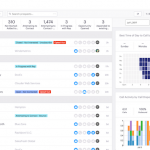8 ways to automate your IT service desk
On a Monday morning, Adam, a help desk technician greets everyone at office refreshingly and opens his laptop. Once he logs into his service desk software, he is bombarded with un-categorized incidents with neither priority set nor technician assigned. Before even glancing at the incidents properly, he is in a great desperation to categorize incidents, prioritize them and forward to the concerned technicians within his organization. After dispatching all incidents, he starts working on his own incident in an extreme hurry.
To engage your technicians productively, let them concentrate more on providing quality customer support by making the help desk system automated. Automate all the routine repetitive tasks using planned help desk workflows and deliver timely customer service. Reduce your technician workload, eliminate manual errors and provide consistent IT support.
This article guides you through the ways to automate your IT service desk efficaciously. I suggests you to bookmark this article as an ITSM automation checklist for your IT service desk software.
Organize incoming requests
On receiving an email, typical help desk automation should be in place – converting the email to incident automatically. It doesn’t stop here and the next flow continues. Incident gets auto-categorized based on the subject and description of the email through email parsing commands and gets assigned to a concerned technician who handles that category-related issues. Based on the criteria like job title of the requester and urgency, priority of the incident has to be auto-defined. Define a proper help desk workflow and make use of the help desk system as effectively as possible to bring out the desired automation to match your organization requirements.
Deliver IT support effortlessly
It’s common for any support representative to resolve same kind of queries again and again and provide same set of resolutions. But it consumes more time, if the technician drafts it repeatedly. Then comes the necessity of canned templates. Most of the help desk systems come with huge set of pre-defined templates to help your technicians on replies and resolutions. All fields get pre-populated in a single click. Same way, service request templates and incident templates facilitate your end users to request for a service or report an issue in a second.
Auto-import users
Typical help desk software allows you to import users through CSV or active directory. Say if you hire 20 employees every week and changed phone no and location of quite a few employees, do you have to enter all these manually? Certain help desk systems automate this by importing new users into the application dynamically when they send email or submit their first incident through self-service portal. It also facilitates you to replace user’s old details with new ones automatically.
Auto-transition between statuses
From creation to closure, incident travels between various statuses in the order – open, assigned, on-hold, resolved and closed. By default, incident gets created under open status and automatically moves to assigned state when a technician gets assigned to it. If technician waits for more information from the requester to resolve the incident, it gets moved to on-hold status. When requester fails to respond for a long time, automation can be enabled to schedule incident closure after a specific period. Closure can be done only after user acknowledgement and if the requester doesn’t acknowledge the resolution provided, rules can be applied to re-open the incident on user’s reply through email or self-service portal.
Assign technicians / agents
Assigning technicians, if not automated, can be a nightmare. It may lead to a huge disaster, if incident gets assigned to an un-appropriate technician. By automation, technicians can either gets assigned based on their skill-set, round robin or load-balancing model. E.g.: If the incident is on network problem, help desk system gets it assigned to rob, network expert who has the highest load. And if you enabled load-balancing model, considering Rob’s load, it gets assigned to another network technician. It can also be assigned in a rounded fashion by automating through round robin method.
Set up automated SLAs
Responding and resolving any incident on time prevents customer issues from falling under the cracks. By default, SLA timer should not be running during on-hold status of the incident. SLAs can be automated with rules based on defined criteria. E.g.: If the priority of incident is high, it has to be responded within 1 hour and resolved within 1 day. If elapsed, proactive or reactive escalation should happen and gets assigned to certain group or a technician automatically. This automation helps to resolve incidents in timely manner, analyze incident trends and observe technician’s efficiency.
Filter spam and auto-reply emails
Your IT help desk support may receive un-expected spam emails and auto-reply emails automatically converted as incidents inside the system. It’s a pain to delete all those mails and the only remedy is smart filtering. Spam filter has to be enabled through canned criteria E.g.: If email subject contains ‘out of office’ or ‘undelivered to sender’ or if the sender contains ‘postmaster’ in it, you can prevent those emails from converting as incidents. A simple automation can save lots of your technician’s time and effort.
Automate repetitive tasks
There are certain tasks performed by your technicians on a regular basis – daily, weekly, monthly or yearly basis. Instead of creating tasks or incidents every time, you can trigger them automatically by periodic scheduling. Say, if Bob needs to change the printer toner every month, scheduled automation triggers an incident every month and assign it to Bob automatically. The same applies, if you want to assign a specific task to a technicians group. Say, if someone from sys-admin team has to monitor security patch every week, automating it triggers an incident every week, assigns it to sys-admin team and notify the group.
Enabling all recommended automation processes, customized as per your business requirements reduces your technician’s workload to a greater extent, cut down IT costs and time.
Author bio:
Priya is an ITSM consultant. She is a ManageEngine certified professional and administering ManageEngine ServiceDesk Plus for help desk functionality. Apart from ITSM, she has a great affair on SEO and digital marketing.
















